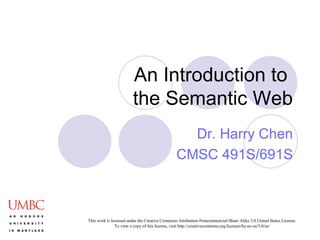8. Okay, so HTML is not helpful Maybe we can tell the machine what the different parts of the text represent? title time speaker location abstract biosketch host 9. XML to rescue? XML fans propose creating a XML tag set to use for each application. For talks, we can choose <title>, <speaker>, etc. <title> <time> <speaker> <location> <abstract> <biosketch> <host> </host> </biosketch> </abstract> </location> </time> </speaker> </title> 10. XML machine accessible meaning But, to your machine, the tags still look like this…. The tag names carry no meaning. XML DTDs and Schemas have little or no semantics. 12. But there are many schemas <?xml version="1.0" encoding="utf-8"?> <xs:schema xmlns:xs="http://www.w3.org/2001/XMLSchema"> <xs:element name="book"> <xs:complexType> <xs:sequence> <xs:element name="title" type="xs:string"/> <xs:element name="author" type="xs:string"/> <xs:element name="character" minOccurs="0" maxOccurs="unbounded"> <xs:complexType> <xs:sequence> <xs:element name="name" type="xs:string"/> <xs:element name="friend-of" type="xs:string" minOccurs="0" maxOccurs="unbounded"/> <xs:element name="since" type="xs:date"/> <xs:element name="qualification" type="xs:string"/> </xs:sequence> </xs:complexType> </xs:element> </xs:sequence> <xs:attribute name="isbn" type="xs:string"/> </xs:complexType> </xs:element> </xs:schema> XML Schema file 42 <?xml version="1.0" encoding="utf-8"?> <xs:schema xmlns:xs="http://www.w3.org/2001/XMLSchema"> <xs:element name="book"> <xs:complexType> <xs:sequence> <xs:element name="title" type="xs:string"/> <xs:element name="author" type="xs:string"/> <xs:element name="character" minOccurs="0" maxOccurs="unbounded"> <xs:complexType> <xs:sequence> <xs:element name="name" type="xs:string"/> <xs:element name="friend-of" type="xs:string" minOccurs="0" maxOccurs="unbounded"/> <xs:element name="since" type="xs:date"/> <xs:element name="qualification" type="xs:string"/> </xs:sequence> </xs:complexType> </xs:element> </xs:sequence> <xs:attribute name="isbn" type="xs:string"/> </xs:complexType> </xs:element> </xs:schema> XML Schema file 1 <title> <time> <speaker> <location> <abstract> <biosketch> <host> </host> </biosketch> </abstract> </location> </time> </speaker> </title> 13. There’s no way to relate schema <?xml version="1.0" encoding="utf-8"?> <xs:schema xmlns:xs="http://www.w3.org/2001/XMLSchema"> <xs:element name="book"> <xs:complexType> <xs:sequence> <xs:element name="title" type="xs:string"/> <xs:element name="author" type="xs:string"/> <xs:element name="character" minOccurs="0" maxOccurs="unbounded"> <xs:complexType> <xs:sequence> <xs:element name="name" type="xs:string"/> <xs:element name="friend-of" type="xs:string" minOccurs="0" maxOccurs="unbounded"/> <xs:element name="since" type="xs:date"/> <xs:element name="qualification" type="xs:string"/> </xs:sequence> </xs:complexType> </xs:element> </xs:sequence> <xs:attribute name="isbn" type="xs:string"/> </xs:complexType> </xs:element> </xs:schema> <?xml version="1.0" encoding="utf-8"?> <xs:schema xmlns:xs="http://www.w3.org/2001/XMLSchema"> <xs:element name="book"> <xs:complexType> <xs:sequence> <xs:element name="title" type="xs:string"/> <xs:element name="author" type="xs:string"/> <xs:element name="character" minOccurs="0" maxOccurs="unbounded"> <xs:complexType> <xs:sequence> <xs:element name="name" type="xs:string"/> <xs:element name="friend-of" type="xs:string" minOccurs="0" maxOccurs="unbounded"/> <xs:element name="since" type="xs:date"/> <xs:element name="qualification" type="xs:string"/> </xs:sequence> </xs:complexType> </xs:element> </xs:sequence> <xs:attribute name="isbn" type="xs:string"/> </xs:complexType> </xs:element> </xs:schema> Either manually or automatically. XML Schema is weak on semantics. XML Schema file 42 XML Schema file 1 <title> <time> <speaker> <location> <abstract> <biosketch> <host> </host> </biosketch> </abstract> </location> </time> </speaker> </title> 19. The Semantic Web Layer Cake Do you think this view is still valid in today’s Web? 34. Let’s start with XML “ XML is Lisp's bastard nephew, with uglier syntax and no semantics. Yet XML is poised to enable the creation of a Web of data that dwarfs anything since the Library at Alexandria.” -- Philip Wadler, Et tu XML? The fall of the relational empire , VLDB, Rome, September 2001. 39. RDF is the first SW language <rdf:RDF ……..> <….> <….> </rdf:RDF> XML Encoding Graph stmt(docInst, rdf_type, Document) stmt(personInst, rdf_type, Person) stmt(inroomInst, rdf_type, InRoom) stmt(personInst, holding, docInst) stmt(inroomInst, person, personInst) Triples RDF Data Model Good for Machine Processing Good For Human Viewing Good For Reasoning RDF is a simple language for building graph based representations 42. RDF and RDF Schema <rdf:RDF xmlns:g=“http://schema.org/gen” xmlns:u=“http://schema.org/univ”> <u:Chair rdf:ID=“john”> <g:name>John Smith</g:name> </u:Chair> </rdf:RDF> <rdfs:Property rdf:ID=“name”> <rdfs:domain rdf:resource=“Person”> </rdfs:Property> <rdfs:Class rdf:ID=“Chair”> <rdfs:subclassOf rdf:resource= “ http://schema.org/gen#Person”> </rdfs:Class> u:Chair John Smith rdf:type g:name g:Person g:name rdfs:Class rdfs:Property rdf:type rdf:type rdf:type rdfs:subclassOf rdfs:domain
